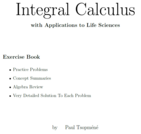
A collection of problems relevant to most Calculus I courses.
- Subject:
- Calculus
- Mathematics
- Material Type:
- Homework/Assignment
- Provider:
- University of British Columbia
- Author:
- Andrew Rechnitzer
- Elyse Yeager
- Joel Feldman
- Date Added:
- 08/30/2023

A collection of problems relevant to most Calculus I courses.

This textbook covers single variable Integral Calculus. Problem book is available.

A companion to the CLP-2 Integral Calculus textbook.

This textbook covers multivariable Calculus. There are chapters on vectors and geometry in 2 and 3 dimensions, partial derivatives, and multivariable integrals.
Problem book available.

Companion to CLP-3 Multivariable Calculus textbook.

This textbook covers Vector Calculus. There are chapters on curves, vector fields, surface integrals and integral theorems (such as the divergence theorem).
Problem book available.

Companion to CLP-4 Vector Calculus.

The most important way to learn calculus is through problem-solving. While going through the solution to a problem, students are often faced with several issues. They may not see the connection between the concept taught in class and the solution. Others may not understand the solution because a step is missing or there are insufficient explanations. Or because they have weak algebra skills. The main goal of this exercise book is to address these issues to help students learn the material more efficiently and get better results. The book contains a wide variety of problems in integral calculus and multivariable calculus, with applications in differential equations, probability, management, and economics. Every problem has a very detailed solution, and the book is self-contained, as the summary for every concept is provided.

The most important way to learn calculus is through problem-solving. While going through the solution to a problem, students often face several issues. They may not see the connection between the concept taught in class and the solution. Others may not understand the solution because a step is missing or there are insufficient explanations. Or because they have weak algebra skills. The main goal of this exercise book is to address these issues to help students learn the material more efficiently and get better results. The book contains a wide variety of problems in differential calculus with applications in management and economics. Every problem has a very detailed solution, and the book is self-contained, as the summary for every concept is provided.
The case study involves the B.C. groundfish trawl fishery, which came under attack from ENGOs in the mid-2000s for destruction of the aquatic habitat. Specifically, the ENGOs were concerned with he destruction of numerous coral and sponge species. The ENGOs were able to give their complaints economic teeth by threatening the industry’s access to major markets. The resource manager, the federal government, was unable to address the problem effectively at the time. The initiative to deal with the problem was taken by the industry, leading to industry –ENGO negotiations. This would never have been possible, if the industry had been unable to act as a cohesive whole. How this intra-industry cooperation was achieved is not yet fully clear. Be that as it may, the negotiations were successful and led to the world’s first habitat bycatch limitation agreement, which came into place in 2012. The case study examines the negotiations and the degree of success of the agreement. It raises the question of the applicability of the B.C. experience to other fisheries in Canada and the rest of the world.
Drawing from a case study of the Northern Gateway (Enbridge) pipeline project we consider if it is possible to reconcile or mediate the conflicting objectives and goals of the resource proponent and the First Nations whose lands the pipeline will traverse. We will draw from the existing legal precedents and a consideration of approaches taken to such disputes in similar settings in other settler-colonial societies such as New Zealand and Australia. In considering the efficacy of Canadian legal measures we need to consider the place and role of Indigenous laws and if they are given sufficient weight in disputes such as this.
What distribution of adjustment costs for climate change mitigation is fair, and should be acceptable to the most (important) countries? Are there ways of framing the issue that could be more effective in galvanizing effective action?

There is no common agreed definition of illegal logging. Below are three perspectives of what constitutes illegal logging: firstly, that of The Royal Institute of International Affairs (RIIA), an international policy analysis institute, secondly, from Global Witness, an international Rights NGO, and thirdly, from the Indigenous Network on Economies and Trade (INET), a Canadian Aboriginal NGO.

This exercise book contains a wide variety of problems in integral calculus, linear algebra, and linear regression, with applications to differential equations, probability, and life sciences. Every problem has a very detailed solution, and the book is self-contained, as the summary for every concept is provided. The book aims to help students learn the material more efficiently and get better results.

One of a set of toolkits to support student development and personal reflection. Produced by students for students.

One of a set of toolkits to support student development and personal reflection. Produced by students for students.

One of a set of toolkits to support student development and personal reflection. Produced by students for students.

One of a set of toolkits to support student development and personal reflection. Produced by students for students.

One of a set of toolkits to support student development and personal reflection. Produced by students for students.

One of a set of toolkits to support student development and personal reflection. Produced by students for students.